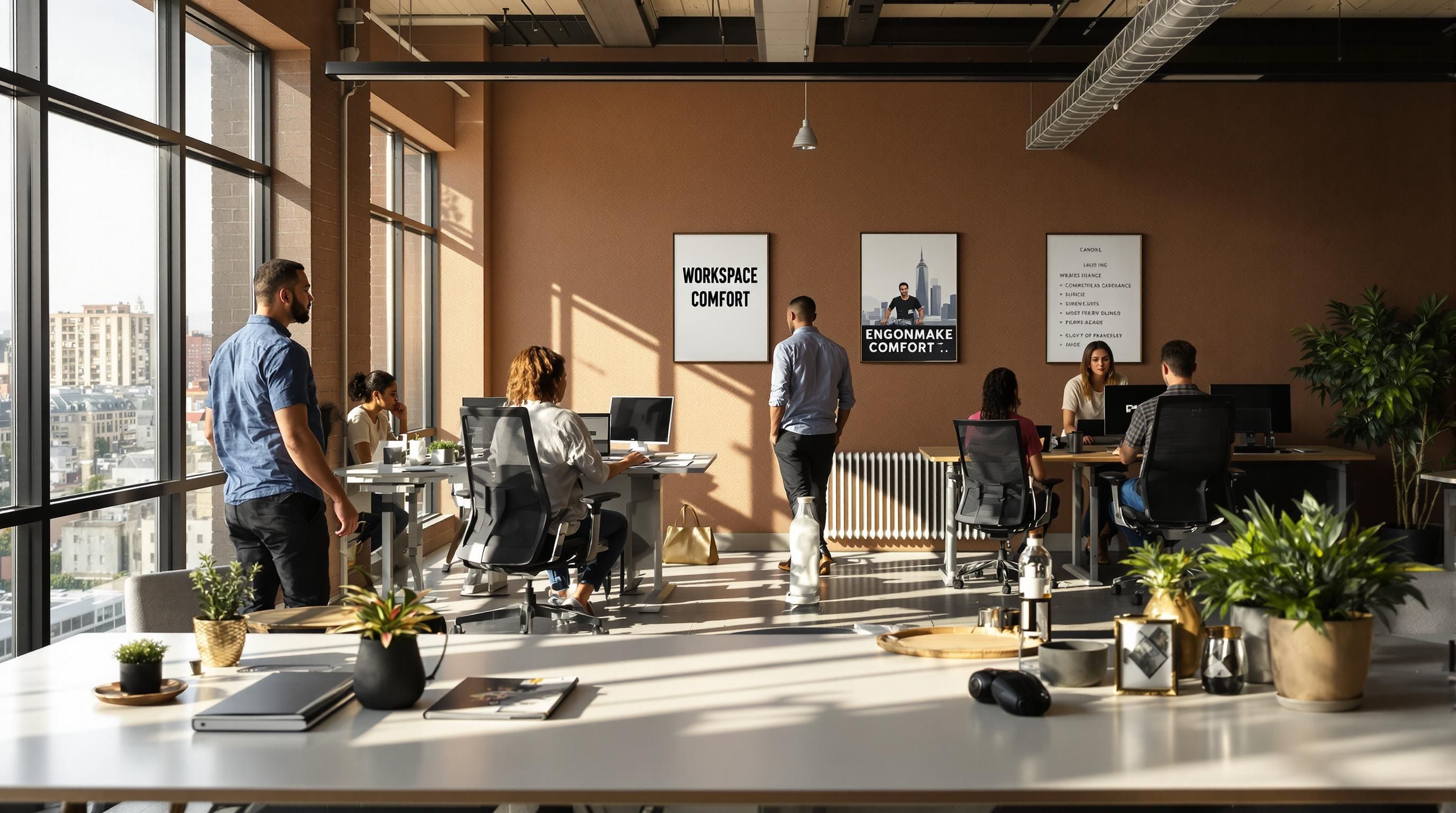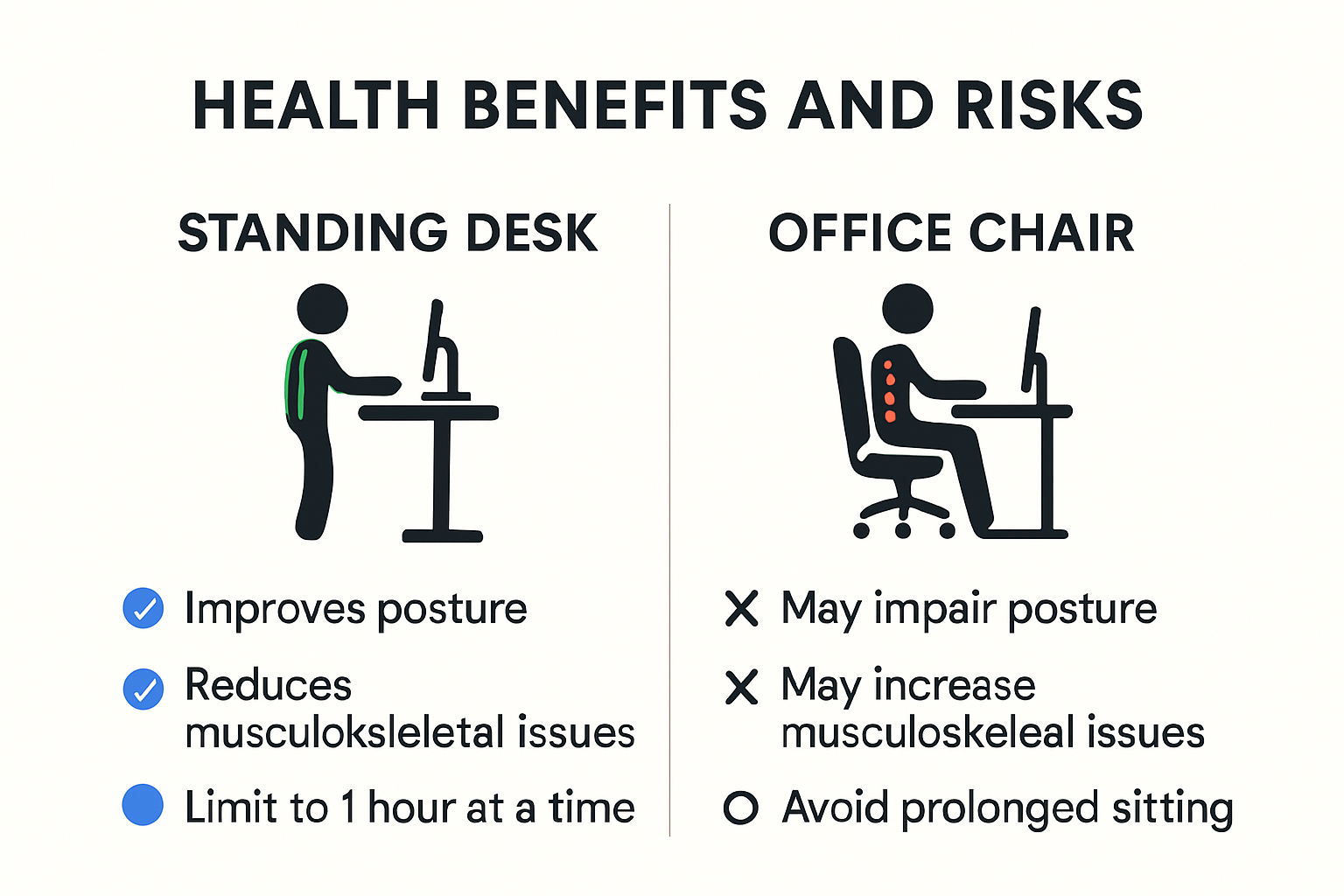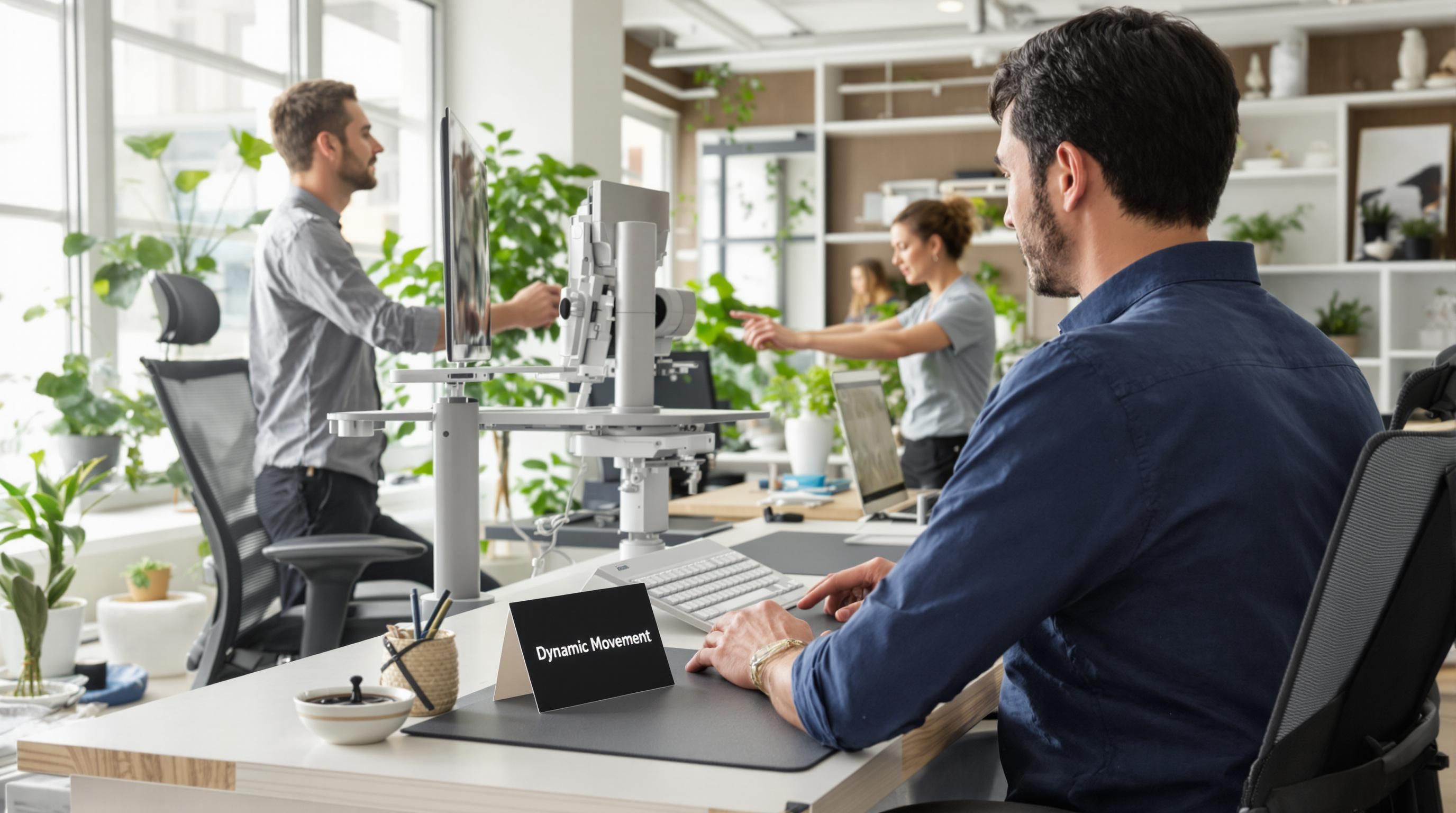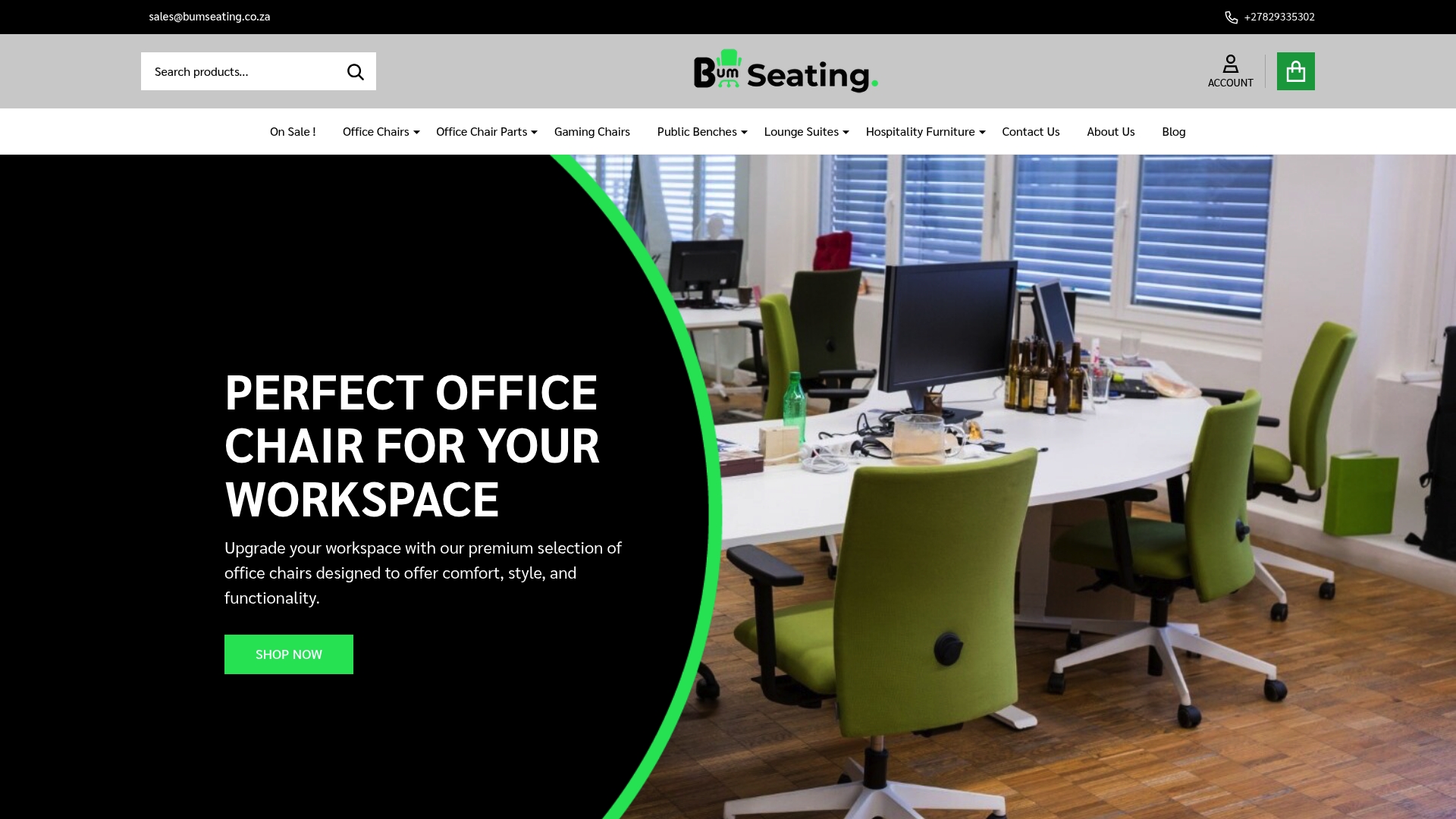Standing Desk vs Office Chair: Best Choice for SA Workspaces 2025
27th Jul 2025
Standing Desk vs Office Chair: Best Choice for SA Workspaces 2025

Standing desks are on the rise in South African offices, with more professionals trading in their old office chairs for a chance to move and stretch while they work. Yet, here is something that might catch you off guard. A review of 53 studies found that only 7% showed real productivity boosts from sit-stand desks. Turns out, the true winner in workspace comfort and performance could be a blend of both options, not just picking sides.
Table of Contents
- Comparing Health Benefits And Risks
- Productivity And Comfort In The Workplace
- Cost, Durability, And Space For South African Offices
- Choosing The Right Solution For Your Workspace
Quick Summary
| Takeaway | Explanation |
|---|---|
| Alternate between sitting and standing | Regularly switching positions reduces discomfort and enhances overall ergonomics in the workspace. |
| Invest in ergonomic furniture | Selecting quality, adjustable furniture provides long-term health benefits and improved productivity. |
| Incorporate movement breaks | Short stretching and walking breaks can significantly alleviate physical strain throughout the workday. |
| Personalize your workspace setup | Tailoring your workspace according to individual needs boosts both comfort and efficiency. |
| Evaluate cost-effectiveness over time | Consider total ownership costs and long-term benefits when selecting workspace solutions. |
Comparing Health Benefits and Risks
In the ongoing debate of standing desk vs office chair, understanding the health implications becomes crucial for South African professionals seeking optimal workspace solutions. Bum Seating recognizes that workspace ergonomics directly impact employee wellness and productivity.
Musculoskeletal Considerations
Standing desks offer unique physiological benefits but also present potential risks. Harvard Health highlights that while standing desks can reduce sedentary behavior, prolonged standing might lead to musculoskeletal discomfort. Professionals should aim for balanced movement rather than static positioning.
Research indicates that alternating between sitting and standing can mitigate potential joint strain. UCLA Health emphasizes that proper ergonomic setup is crucial to prevent increased pressure on lower extremities and maintain overall body alignment.

Metabolic and Energy Expenditure Insights
Standing workstations demonstrate measurable metabolic advantages. Journal of Physical Activity and Health revealed that sit-stand desks significantly reduced physical fatigue among overweight and obese workers during simulated workdays. This finding suggests potential benefits beyond mere positional changes.
Metabolic research indicates that standing increases caloric expenditure compared to sitting. An average person might burn approximately 88 calories per hour while standing versus 72 calories while seated. However, these differences become meaningful only with consistent, mindful movement throughout the workday.
To help visualise the effect of standing vs sitting on calorie burn and fatigue, here’s a summary table for quick reference:
| Position | Calories Burned per Hour | Fatigue Reduction in Overweight/Obese Workers |
|---|---|---|
| Sitting | 72 | Lower (fatigue not notably reduced) |
| Standing | 88 | Significantly reduced |
| Alternating (Both) | Varies, typically higher | Significantly reduced when used correctly |
Balanced Workspace Strategy
Bum Seating recommends a nuanced approach to workspace ergonomics. Rather than viewing standing desks and office chairs as competing solutions, professionals should consider them complementary tools. The ideal strategy involves dynamic movement, allowing periodic transitions between sitting and standing positions.
Key recommendations include:
- Gradual Adaptation: Introduce standing periods incrementally, starting with 15-30 minute intervals
- Proper Posture: Maintain neutral spine alignment whether sitting or standing
- Regular Movement: Incorporate stretching and walking breaks
Professionals seeking optimal workspace wellness should consult ergonomic specialists and listen to their body’s signals. Bum Seating remains committed to providing flexible seating solutions that support individual health requirements and workplace comfort.
Ready to transform your workspace? Explore Bum Seating’s ergonomic solutions and discover personalized comfort strategies tailored to your unique needs.

Productivity and Comfort in the Workplace
Workspace design plays a critical role in employee performance, and the standing desk vs office chair debate directly impacts workplace productivity and comfort. Bum Seating understands that creating an optimal work environment goes beyond simple furniture selection.
Ergonomic Performance Insights
Contrary to popular belief, the relationship between workspace furniture and productivity is nuanced. A comprehensive scoping review analyzing 53 studies revealed that while sit-stand desks effectively reduce sedentary time, their direct impact on work performance remains limited. Only 7% of work performance outcomes showed statistically significant improvements.
However, research from occupational health studies suggests that sit-stand workstations can significantly reduce physical discomfort. Six out of seven studies reported lower levels of reported workplace discomfort, indicating that employee comfort might indirectly contribute to sustained productivity.
To clarify the findings on productivity and discomfort related to standing desks versus chairs, see the comparison table below:
| Outcome | Standing/Sit-Stand Desk | Office Chair |
|---|---|---|
| Work Performance Improvements | Only 7% of outcomes improved | No mention of improvement |
| Sedentary Time | Effectively reduced | Higher |
| Physical Discomfort | Significantly reduced (6 of 7 studies) | Higher |
Psychological Well-being and Work Dynamics
Workplace furniture selections extend beyond physical comfort into psychological well-being. A systematic review examining standing and alternative desks highlighted mixed results regarding psychological impacts. While treadmill desks showed improvements in physiological outcomes, standing desks demonstrated limited effects on psychological well-being.
Bum Seating recognizes that individual preferences and working styles vary. Some professionals might experience enhanced focus and energy through dynamic workspace setups, while others might find consistent positioning more conducive to concentration. The key lies in providing flexible solutions that accommodate diverse work preferences.
Strategic Workspace Configuration
Creating an effective workspace requires a holistic approach. Professionals should consider:
- Personalized Adjustability: Select furniture that allows individual customization
- Movement Encouragement: Incorporate furniture that promotes natural body movement
- Comfort Prioritization: Choose solutions that support sustained comfort throughout workdays
Bum Seating recommends a balanced approach that combines ergonomic office chairs with occasional standing opportunities. This strategy allows professionals to maintain productivity while minimizing physical strain.
Employees and employers alike benefit from understanding that workspace comfort is not a one-size-fits-all solution. Continuous assessment and willingness to adapt workspace configurations can lead to improved overall work experiences.
Ready to revolutionize your workspace? Explore Bum Seating’s ergonomic solutions and discover furniture that supports your unique professional needs.
Cost, Durability, and Space for South African Offices
For South African businesses navigating the standing desk vs office chair landscape, understanding the economic and spatial implications becomes crucial. Bum Seating recognizes that workspace investments require strategic financial and practical considerations.
Economic Investment and Long-term Value
The financial landscape of workplace ergonomics reveals compelling insights. Research on workplace interventions demonstrates that height-adjustable workstations can yield significant returns. An investment of approximately 392.40 per employee potentially generates a net benefit of 1,770.32 over 12 months, representing a remarkable 256% return on investment.
However, cost-effectiveness varies. Scientific studies indicate that low-cost standing desks can reduce occupational sitting time by 42 minutes daily over three months. Critically, these reductions were not sustained at six months, suggesting that initial affordability does not guarantee long-term effectiveness.
Here’s a table outlining cost, savings, and returns related to ergonomic workplace investments mentioned in this section:
| Item/Intervention | Cost per Employee | Net Benefit over 12 Months | Return on Investment | Sustained Effect (6 months) |
|---|---|---|---|---|
| Height-adjustable workstations | 392.40 | 1,770.32 | 256% | Not specified |
| Low-cost standing desks | Lower | Reduced sitting (42 min/day over 3 months) | Not specified | Not sustained |
Durability and Workspace Efficiency
Durability remains a paramount consideration for South African offices. Economic evaluations suggest standing desks can have an expected lifespan of 10 years, translating to an intervention cost of just 7.58 per user annually. This longevity makes them an attractive option for businesses seeking sustainable workspace solutions.
Space optimization is equally critical. Modern South African offices increasingly prioritize flexible, multi-functional furniture. Bum Seating recommends exploring compact seating solutions that maximize workspace efficiency without compromising ergonomic quality.
Strategic Workspace Investment
Successful workspace design balances multiple factors:
- Cost Considerations: Evaluate total cost of ownership, not just initial purchase price
- Flexibility: Choose furniture supporting dynamic work environments
- Space Utilization: Select solutions that optimize available square meterage
Bum Seating understands that each South African business has unique spatial and budgetary constraints. Our approach emphasizes providing versatile seating solutions that deliver exceptional value without unnecessary expenditure.
While standing desks and ergonomic chairs represent significant investments, they are ultimately investments in employee health, productivity, and workplace satisfaction. Careful selection can transform workplace dynamics, creating environments that support both individual well-being and organizational performance.
Ready to optimize your workspace? Explore Bum Seating’s innovative seating solutions and discover how strategic furniture choices can elevate your office environment.
Choosing the Right Solution for Your Workspace
Selecting the ideal workspace solution requires careful consideration of individual needs, work requirements, and physical health. Bum Seating understands that no single approach fits every professional environment, making personalized ergonomic choices crucial for optimal workplace performance.
Individual Assessment and Ergonomic Customization
A comprehensive systematic review highlights the critical importance of personalized workspace strategies. The research emphasizes that alternating between sitting and standing provides superior ergonomic benefits compared to static positioning. This nuanced approach suggests professionals should prioritize flexibility over rigid workspace configurations.
Occupational Safety guidelines reinforce the need for tailored workstation solutions. Each individual’s physical characteristics, job responsibilities, and health considerations must inform furniture selection. Factors like body height, weight, existing musculoskeletal conditions, and typical work tasks play significant roles in determining the most appropriate seating or standing arrangements.
Practical Implementation Strategies
Implementing an effective workspace solution involves strategic decision-making. Professionals should consider:
- Physical Comfort: Assess individual physical requirements and potential limitations
- Task Compatibility: Match furniture to specific work responsibilities
- Adaptability: Choose solutions allowing dynamic positioning
Bum Seating recommends a gradual transition when introducing new workspace configurations. Start with short periods of standing or alternative positioning, progressively increasing duration as your body adapts. This approach minimizes potential discomfort and allows for natural physiological adjustment.
Holistic Workspace Design
Effective workspace design transcends simple furniture selection. It requires a holistic understanding of individual work patterns, physical health, and productivity requirements. Explore our ergonomic chair range to discover solutions that support your unique professional needs.
Professionals should view their workspace as a dynamic environment capable of evolving with their changing requirements. Regular reassessment of workspace configurations ensures continued comfort, productivity, and overall well-being.
Consult with ergonomic specialists, listen to your body’s signals, and remain open to experimenting with different workspace setups. The ideal solution often emerges through thoughtful exploration and personalized adaptation.
Ready to transform your workspace? Discover Bum Seating’s innovative ergonomic solutions and unlock your professional potential through intelligent workspace design.
Frequently Asked Questions
What are the benefits of using a standing desk compared to an office chair?
Using a standing desk can help reduce sedentary behavior, increase caloric expenditure, and improve overall ergonomics. However, studies show that alternating between sitting and standing often provides the best balance for comfort and productivity.
How does using a standing desk affect productivity in the workplace?
Research indicates that while standing desks can reduce discomfort and sedentary time, they do not always result in significant productivity boosts. Only 7% of studies showed improved work performance with sit-stand desks. Comfort plays a crucial role in overall productivity.
What ergonomic features should I look for in a workspace?
When selecting ergonomic furniture, look for adjustable heights, lumbar support, and features that encourage natural body movement. It’s important to assess individual needs based on height, weight, and typical work tasks to ensure a comfortable workspace setup.
How can I transition to a standing desk effectively?
To transition effectively, start by introducing standing periods gradually—aim for 15-30 minutes initially, and increase duration as you adapt. Also, maintain proper posture and incorporate regular movement breaks to minimize strain.
Upgrade Your Workspace Comfort: Combine Knowledge with Action
Are you struggling to find the perfect balance between sitting and standing throughout your workday? The article highlights how alternating between a quality office chair and standing time helps prevent discomfort, boost energy, and increase focus. Yet, making this shift can be daunting without the right ergonomic support. Many South Africans share the frustration of workplace fatigue, aches, and wasted potential. A personalised solution is key to real results.

Step into a new era of productivity with Bum Seating’s ergonomic office chairs and seating solutions, thoughtfully crafted for South African workspaces. Explore high-performance office chairs designed to match your unique needs and keep you comfortable through every shift. Your body deserves a setup that follows the expert advice from our article—offering flexible posture, reliable support, and modern design. Ready to feel the difference? Visit https://bumseating.co.za and shop now to transform your office comfort today.
Recommended
- Top Office Furniture Planning Tips for Smart Spaces 2025 - Bum Seating
- Innovative Seating Solutions 2025: Smart Choices for SA Offices - Bum Seating
- Office Chair Features Explained: A Guide for South Africa 2025 - Bum Seating
- Banquet Stacker Chair | Bum Seating
- Best Gaming Chairs | Gaming Chair Ranking | Мusic Gateway
